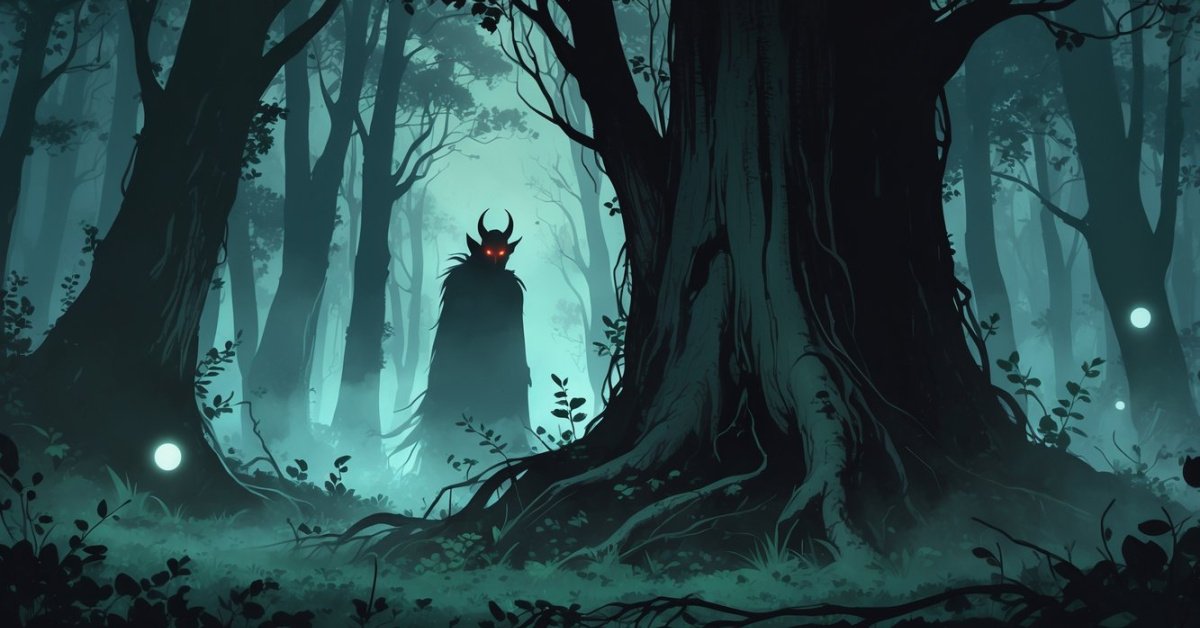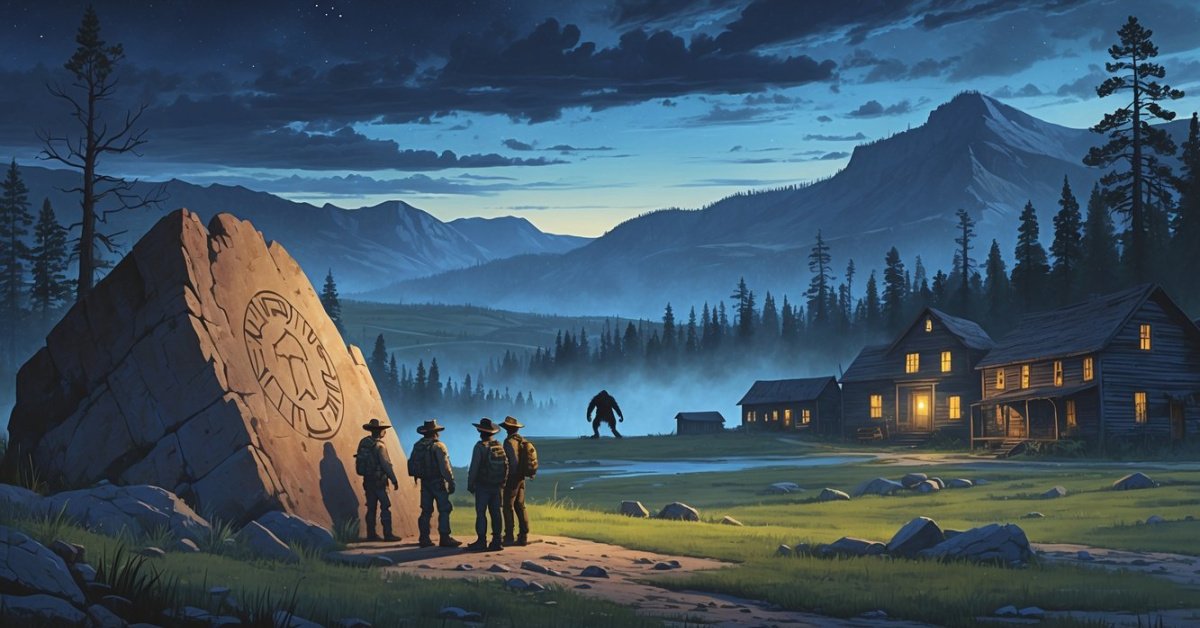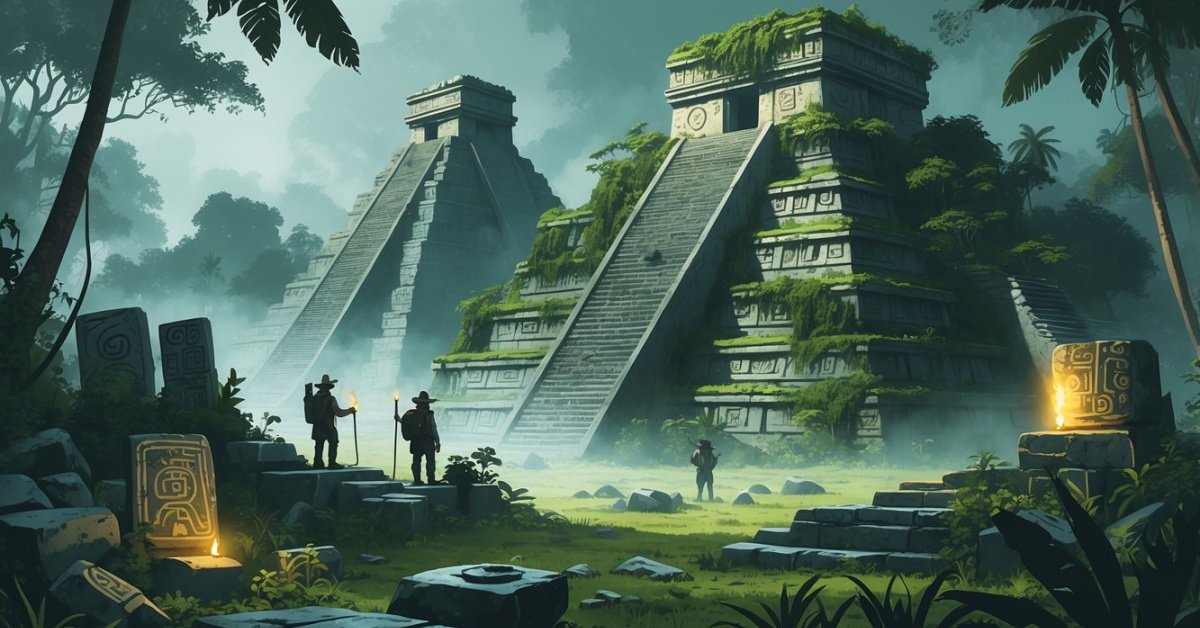Some forests hold more than just wildlife and trees. They carry stories of strange sounds, shadowy figures, and unexplained events that people have passed down for generations.
Devil in the Forest explores how certain wooded areas develop a reputation for paranormal activity and what investigators discover during their visits.

From New Jersey’s Pine Barrens, home to the legend of the Jersey Devil, to remote woodlands tied to dark rituals, these places attract both thrill-seekers and researchers.
People enter with cameras, recorders, and open minds, hoping to find signs of spirits, demons, or unexplained forces.
The fascination comes from the mix of natural beauty and unsettling mystery.
A quiet trail can suddenly feel heavy with tension.
An ordinary clearing can hold traces of past events.
This blend of history, folklore, and investigation makes haunted forests a unique and interesting subject for anyone curious about what might be hiding among the trees.
The Allure of Haunted Forests
Dense woods often hold a mix of beauty and unease.
Many remote areas have a history of strange events and unexplained sounds that make people wonder what might be hiding among the trees.
Why Forests Attract Paranormal Activity
Forests are naturally quiet and isolated.
Unusual sounds stand out more in these settings.
At night, low light and moving shadows can make people misinterpret what they see or hear.
Some believe that natural features like running water or certain minerals in the soil can hold or increase energy.
This idea appears in many paranormal investigations.
Large wooded areas often keep sites where past events occurred.
Old battlefields, abandoned settlements, or sacred lands can become haunted locations when stories of tragedy or mystery remain tied to the land.
Famous Haunted Woods Across the World
The Freetown-Fall River State Forest in Massachusetts is part of the Bridgewater Triangle, an area known for reports of cult activity, UFO sightings, and violent crimes.
Visitors have heard voices and seen strange lights there.
In the UK, Epping Forest has a long history of robberies and murders.
Many say its atmosphere changes suddenly, as if someone unseen is watching.
Japan’s Aokigahara Forest, at the base of Mount Fuji, is known for its tragic past.
Its dense trees block wind and sound, creating an unsettling stillness that adds to its reputation as one of the most haunted forests in the world.
Legends and Local Folklore
Many haunted woods connect to specific legends.
In Appalachian folklore, warnings like “Don’t look in the trees” come from tales meant to protect people from dangers in the wilderness.
Some stories involve ghostly figures who appear to travelers as a warning.
Others tell of curses placed on the land after betrayal or violence.
Local communities pass these stories down through generations.
Sometimes, the tales come from real events.
In other cases, they serve as cautionary myths that explain the strange feelings people get in remote, wooded areas.
Unveiling the Devil in the Forest
Some forests have long histories of strange events tied to local beliefs.
In certain places, unexplained sounds and unusual sightings add to the mystery.
These details often connect to older stories that mix history with superstition.
Origins of the Devil Legends
Many “Devil in the Forest” legends come from early European folklore.
In medieval times, people often linked remote woods to spirits or demons.
They believed these entities guarded the land or punished trespassers.
Local tales sometimes grew from real events.
For example, people blamed supernatural forces for unexplained disappearances or violent crimes.
This helped communities explain dangers they did not fully understand.
Some legends also reflect religious change.
When Christianity replaced older pagan beliefs, people reimagined forest spirits as evil beings.
Texts like Gene Wolfe’s The Devil in a Forest show how such myths can reflect social conflict.
Common Paranormal Phenomena in the Woods
Witnesses often report certain types of paranormal activity in these forests.
Common accounts include:
- Shadow figures moving between trees.
- Unusual lights or glowing orbs at night.
- Sudden temperature drops in small areas.
Others describe hearing whispers, footsteps, or branches snapping when no one is visible.
Wildlife sometimes reacts strangely, going silent or fleeing without cause.
These reports often happen in the same spots, suggesting possible “hot zones” of activity.
Sometimes, audio recorders or cameras capture unexplained voices or distortions.
While this does not prove a supernatural cause, it keeps investigators interested.
The Role of Dark Rituals
Dark rituals often play a central role in “Devil in the Forest” stories.
Some tales involve secret gatherings where people sought protection, revenge, or contact with spirits.
Investigators sometimes find symbols carved into trees or arranged stones that could mark ritual sites.
These may connect to older pagan practices or modern occult groups.
Some stories claim that rituals invite demons or other entities.
Whether or not these claims are true, belief alone can affect how people experience the forest.
Fear, expectation, and local legend shape how events are remembered and retold.
Iconic Haunted Forests in the United States
Some forests in the U.S. connect to specific legends or unusual reports that have lasted for generations.
These places often mix history with folklore, attracting visitors who want to see the settings of the stories.
The Pine Barrens and the Jersey Devil
The Pine Barrens in New Jersey cover over one million acres of dense forest and wetlands.
The area contains ghost towns, abandoned mills, and forgotten cemeteries.
Local legend claims the forest is home to the Jersey Devil, a winged creature with a horse-like head and hooves.
Reports of sightings go back to the 1700s.
Many residents treat the Jersey Devil as folklore, but some visitors say they have heard strange cries or seen shadowy figures in the trees.
The Pine Barrens also have a history of strange lights and unexplained footprints.
Hiking trails and canoe routes make it easy to explore.
The remote stretches can feel isolated.
Wildlife such as deer, foxes, and owls can add to the eerie atmosphere.
The Devil’s Tramping Ground
In Chatham County, North Carolina, a barren circle about 40 feet wide stands where no plants grow.
People call this site the Devil’s Tramping Ground.
According to legend, the devil walks in circles here at night, wearing down the ground.
Locals say anything left in the circle will move by morning.
Scientists have tested the soil but have not found a clear reason for the lack of vegetation.
Visitors often camp nearby to watch for unusual activity.
The Devil’s Tramping Ground is easy to reach from the road.
Its isolation at night makes it a popular spot for ghost hunters and curious travelers.
Morgan-Monroe State Forest
Morgan-Monroe State Forest in Indiana covers over 24,000 acres of hardwood trees and rugged hills.
It is known for its quiet trails and historic cemeteries hidden in the woods.
Some visitors report hearing footsteps or voices when no one is nearby.
Others claim to have seen figures vanish into the trees.
One area, called Stepp Cemetery, features ghost stories about a woman in black who guards the graves.
The forest’s dense canopy, old logging roads, and remote clearings help explain why people link Morgan-Monroe State Forest to eerie encounters.
It remains a popular spot for both hikers and paranormal fans.
Investigating Paranormal Activity in the Woods
Investigators often enter wooded areas at night to look for unusual sounds, lights, and sightings.
They use specialized tools, careful observation, and safe practices to increase their chances of recording possible paranormal activity and to stay safe.
Essential Equipment for a Ghost Hunt
A well-prepared ghost hunt in the woods needs both detection tools and basic outdoor gear.
EMF meters can show changes in electromagnetic fields.
Digital voice recorders capture possible EVPs (electronic voice phenomena).
Thermal cameras help spot unexplained heat signatures.
Full-spectrum cameras can capture light outside the visible range, which some believe reveals anomalies.
Investigators also bring flashlights, extra batteries, and headlamps for visibility.
A compass or GPS device helps them avoid getting lost.
For longer investigations, they carry portable seating, weather-appropriate clothing, and a small first aid kit.
Many teams use motion sensors or static domes like those in professional ghost hunts to detect movement when no one is nearby.
Techniques for Gathering Evidence
Investigators start by recording baseline readings for temperature, EMF, and noise.
This helps them notice changes later.
They conduct EVP sessions, asking simple questions and leaving pauses for any possible responses.
Cameras are set to record continuously, especially in areas with reported activity.
Some teams use trigger objects—items believed to attract spirits, such as personal belongings or artifacts.
They place these in view of cameras to detect movement.
Walking slowly and stopping often lets them listen for footsteps, rustling, or voices.
In wooded areas like the Devil’s Forest, patience and stillness are as important as equipment.
Safety Tips for Investigators
Safety is critical during nighttime investigations in the woods.
Investigators should always work in teams and use two-way radios to keep in contact.
They should mark their entry point and use reflective tape or glow sticks to guide their way back.
Checking weather conditions before heading out can prevent problems.
Wildlife awareness is important.
Knowing what animals may be in the area and how to avoid them reduces risk.
Carrying a whistle or air horn can help in emergencies.
They should tell a friend or family member their location and expected return time.
These steps help make sure a ghost hunt does not turn into a rescue mission.
Signs and Manifestations of Forest Hauntings
Paranormal activity in wooded areas often leaves behind specific signs that people can see, hear, or feel.
These signs can include unusual changes in the environment or unexplained sensory experiences without a clear natural cause.
Environmental Clues of the Supernatural
Haunted forests sometimes show sudden and localized changes in temperature. People may feel a sharp drop in warmth in one spot, even when the surrounding air is mild.
Unusual fog or mist can appear without a weather-related reason. Some reports describe this mist taking on shapes or moving in unnatural ways.
Animals often react strangely. Birds may suddenly stop singing, or dogs may refuse to enter certain areas.
In the Freetown State Forest, witnesses have noticed these environmental shifts along with other paranormal reports.
Strong, unexplained odors—like sulfur, decay, or perfume—sometimes signal something strange. These smells often appear briefly and vanish without a clear source.
Common Visual and Auditory Phenomena
People exploring haunted forests often report seeing shadowy figures between trees. These shapes may look like people or animals but disappear when approached.
Ghostly lights, called “orbs” or “will-o’-the-wisps,” appear in places like Old House Woods in Virginia. These lights may hover or move slowly before fading away.
Many visitors hear strange sounds. These include footsteps on dry leaves, distant voices, or the sound of branches snapping.
Sometimes people hear music or chanting with no visible source.
Physical and Emotional Effects
Some visitors to haunted forests feel a sudden sense of being watched. This sensation can cause unease even when no one is nearby.
Physical effects can include chills, dizziness, or a heavy feeling in the chest. These symptoms often appear quickly and fade after leaving the area.
People may also feel sudden fear, sadness, or anxiety without a clear reason. In forests linked to tragic events, such as parts of the Bridgewater Triangle, these feelings are more common.
In rare cases, individuals claim something lightly touched or pushed them when no one else was present.
Dark Rituals and Forest Curses
People have used some forests for occult practices. In certain places, these events connect to strange reports, unexplained sounds, and sightings that locals still discuss today.
Ritual sites and natural isolation often leave a lasting mark on the land.
Historical Accounts of Occult Practices
Historical records and oral stories describe how people once used some wooded areas for dark rituals. These included animal sacrifices, symbolic markings on trees, and gatherings during specific moon phases.
In Massachusetts, the Freetown-Fall River State Forest has long been linked to reports of cult activity. Witnesses have seen hidden clearings where fires burned in circles and strange symbols were carved into stones.
Some accounts mention attempts to summon or contact demons. Older residents often recall warnings from parents and grandparents to avoid certain trails at night.
These stories blend fact with folklore and shape how people view the forest over time.
Impact of Rituals on the Land
Repeated occult gatherings can leave both visible and invisible changes. People have found burned patches of ground, altered vegetation, and scattered animal remains in some locations.
In places like Griffith Park in Los Angeles, reports claim rituals left behind areas where plant growth slowed or stopped. Some hikers believe these spots feel heavy or “charged.”
Local law enforcement sometimes investigates these sites but usually finds only ashes, melted candle wax, or bones. Physical traces can influence how people use the land, even without proof of supernatural forces.
Modern-Day Ritual Legends
Modern stories suggest occult practices continue in some forests. Hikers still find fresh offerings, recently lit candles, or symbols drawn into the dirt.
The Bridgewater Triangle region is one area where such tales persist. Visitors claim to hear chanting or see flickering lights deep among the trees.
Social media spreads these reports, with photos and videos shared widely. While some believe many are staged, the stories keep interest alive.
For locals, these sightings add to the idea that the forest remains a place where the past and present meet in unsettling ways.
Native American Burial Grounds and Spiritual Energy

Many wooded areas in North America contain Native American burial grounds with deep cultural and spiritual meaning. Some of these locations have become known as haunted places where visitors report unusual sights, sounds, or sensations.
Historical Significance of Burial Sites
Native American burial grounds often date back hundreds or thousands of years. People chose these sites carefully, sometimes near rivers, mounds, or other natural landmarks.
These sites served as more than just resting places. They were sacred spaces used for ceremonies, mourning, and honoring ancestors.
Many tribes see these areas as a link between the living and the spirit world. Burial grounds can be part of larger sacred sites that include ceremonial grounds, temples, or natural formations.
Archaeological evidence shows that people often buried items such as pottery, tools, and personal belongings with the deceased. This practice reflected beliefs about life after death and the spirit’s ongoing presence.
Reported Paranormal Experiences
Some people visiting forested burial grounds report unusual activity. These reports include sudden temperature drops, faint voices, or unexplained lights.
Visitors sometimes see shadowy figures or feel a sense of being watched. Many believe these experiences are tied to spirits connected to the land.
Real estate near Native American burial grounds can be less desirable to some buyers due to stories of hauntings or disturbances. Paranormal investigators sometimes include these sites in their research, using tools to detect changes in temperature, electromagnetic fields, or sound.
Many of these findings remain unverified.
Respecting Sacred Forest Locations
When visiting a burial ground in the forest, people should treat the site with respect. These are not just historical landmarks but sacred spaces for living communities.
Visitors should avoid touching or removing any objects. Disturbing the ground or artifacts can damage cultural heritage and break laws that protect such sites.
Many tribes ask people to stay on marked paths and avoid photography during ceremonies or visits. This helps preserve both the physical site and the spiritual atmosphere.
Those exploring haunted forest locations should respect Indigenous traditions. Listening to tribal guidance helps protect these sacred places for future generations.
Demons, Ghosts, and Other Forest Entities
Forests with a history of strange events often have stories of violent attacks, unexplained noises, and sightings of figures that vanish. Some accounts describe harmful forces, while others focus on spirits tied to the land or its history.
Demonic Encounters in the Woods
Reports of demonic activity in wooded areas often involve aggressive behavior toward visitors. Witnesses describe sudden drops in temperature, foul odors, and feelings of intense dread.
Some traditions say demons choose forests as hiding places because of their isolation. Legends claim that figures like Beelzebub or other malevolent beings lurk in dark groves, as told in forest demon folklore.
Common signs of a possible demonic presence include:
| Sign | Description |
|---|---|
| Unnatural silence | Sudden absence of animal sounds |
| Physical marks | Scratches or burns without clear cause |
| Distorted voices | Sounds mimicking people or animals |
Some investigators use protective rituals or avoid these sites at night.
Ghostly Apparitions and Residual Hauntings
People often see ghosts in forests as figures dressed in old clothing or glowing shapes moving between trees. These sightings sometimes connect to past tragedies such as accidents, battles, or disappearances.
In Romania’s Hoia Forest, called the Bermuda Triangle of Romania, visitors report shadowy forms and unexplained lights. Many believe these are residual hauntings—energy imprints repeating events from the past.
Residual hauntings differ from interactive spirits because they do not respond to people and seem trapped in a loop. Ghost hunters often record strange audio or temperature changes in these areas.
Local Legends of Forest Spirits
Many cultures share stories of spirits that protect or punish people in the woods. In Slavic mythology, the Leshy is a guardian spirit who can guide travelers or lead them astray, as described in forest spirit myths.
Some Indigenous groups see forest spirits as protectors of balance in nature. Others warn of trickster entities that lure people deeper into the wild.
These legends often explain odd natural features, such as a clearing where no trees grow or a path that seems to change direction. Locals may avoid certain areas, believing the spirits there are not welcoming.
Famous Paranormal Investigations and Case Studies
Many well-known paranormal cases have happened in wooded areas where people report strange sounds, moving shadows, and unexplained lights. Investigators often use historical research and on-site observation to understand these experiences.
Notable Ghost Hunts in Haunted Forests
Some of the most famous ghost hunts have taken place in forests linked to tragic events. For example, Rendlesham Forest in England has reports of unexplained lights and military sightings.
In the United States, the Freetown-Fall River State Forest in Massachusetts is part of the “Bridgewater Triangle,” an area known for apparitions and odd animal sightings.
Teams like Ed and Lorraine Warren, known for investigating high-profile hauntings, have documented cases where wooded areas seem to amplify paranormal activity. These hunts often use night-vision cameras, audio recorders, and motion sensors.
Patterns in these locations often include:
- Sudden temperature drops in small areas
- Unusual EMF readings without electrical sources nearby
- Disembodied voices captured on digital recorders
Documented Evidence of the Supernatural
Investigators gather evidence from haunted forest locations using technology and witness accounts. Video recordings sometimes show unexplained shadows moving between trees.
Audio evidence, such as Electronic Voice Phenomena (EVP), is common. In several cases, voices have answered direct questions even when no one was present.
Photographs from ghost hunts may show light anomalies, but investigators check for insects, dust, or lens flares before considering them significant. In the Amityville case, the Warrens used still photography and infrared imaging to capture possible anomalies, a method later used in forests.
Some teams also keep detailed logs of environmental conditions, noting wind speed, humidity, and moon phase to find possible natural explanations.
Lessons Learned from Real Investigations
Experienced investigators stress the importance of preparation when exploring haunted forests.
They learn the terrain, bring proper lighting, and create a clear plan for documenting findings.
Investigators always try to debunk claims before making conclusions.
Natural causes, such as animal activity or changing weather, often explain supposed paranormal events.
Researchers in cases like the “Devil on Trial” investigation found that public attention can influence witness accounts.
Careful and unbiased documentation helps them maintain credibility.
Teams usually work in pairs or groups for safety.
They verify each other’s observations in real time to reduce misinterpretation during a ghost hunt.
Tips for Exploring Haunted Forests Responsibly

Exploring haunted forests can involve unusual sights and sounds.
Visitors should balance curiosity with respect for the land, its history, and their own safety.
Ethical Considerations for Investigators
Investigators should respect the cultural and historical significance of the area during a ghost hunt.
Many sites connect to local legends, indigenous traditions, or past tragedies.
They should avoid trespassing and always seek permission when needed.
Carrying written consent is a good practice.
Investigators should not fabricate evidence.
Honest documentation keeps paranormal research credible and prevents misleading others.
Groups should agree on clear rules for behavior.
Shouting or damaging the area can disturb wildlife and disrespect the site’s history.
Protecting Yourself from Harm
Haunted forests can have real dangers beyond the paranormal.
Uneven ground, low visibility, and sudden weather changes can cause injuries.
Wear sturdy boots and weather-appropriate clothing.
Carry a flashlight with spare batteries.
Always include a first-aid kit in your gear.
Bring a map, compass, or GPS device because cell service may not work in remote areas.
Explore in pairs or groups for safety.
Let a friend or family member know your planned route and expected return time.
Preserving the Forest Environment
Haunted forests provide natural habitats for plants and wildlife. Visitors should avoid leaving litter or moving natural objects.
Do not damage trees and plants. Use established trails to prevent erosion and protect sensitive areas.
Investigators should place cameras or sensors carefully to avoid harming vegetation. Avoid making loud noises that can stress wildlife.
Use red-filtered lights during night investigations to reduce disturbance. If you bring food or drink, pack out all waste.
Even biodegradable materials, like fruit peels, can disrupt the ecosystem. Treat the forest with care to keep it safe and respectful for everyone.




